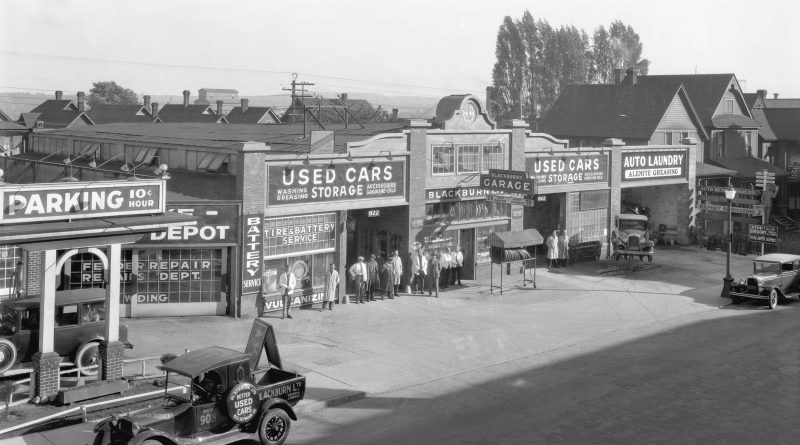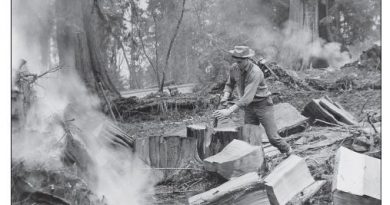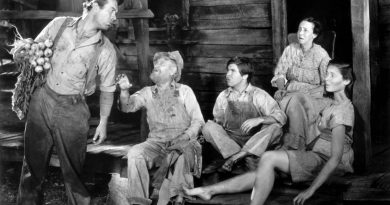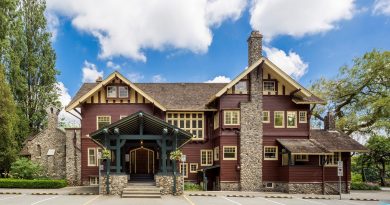1933
Above: Blackburn’s Service Station and used cars, 822 Seymour Street, circa 1928.
[Image: Vancouver City Archives AM54-S4-: Bu N274.2
*****************************************
You’ll note that these years include events listed under “Also in . . .” These are events for which we don’t have a specific date. If YOU know the specific date of an event shown there, please notify us . . . and cite the source! Many thanks!
*****************************************
January 4 Finning Tractor & Equipment Company Ltd. was incorporated.
January 17 The Vancouver Sun turned its newsroom over to students from the University of British Columbia. Staff of the Ubyssey, the student newspaper, took over the layout, placement of stories, the editorial and sports pages, and more.
The Page One story with the most space devoted to it asked several distinguished citizens whether a university education gave a person an advantage in the workplace. The answer, not surprising given that all the people interviewed were UBC teachers, was that it did. Number two story, in terms of space, told how the university was still managing although its budget had been cut. (We were in the depths of the Depression.) Other Page One stories told of a holdup at the Mount View Beer Parlor, a pending visit to the Chicago World’s Fair by the Kitsilano Boys’ Band, the funeral of Premier Tolmie’s wife, and the return from Europe of lumber executive H.R. MacMillan.
Familiar names pop out of the Ubyssey roster of 30 who worked on the paper that day: Norman Hacking, Dick Elson and 19-year-old Stu Keate, who would become its publisher 31 years later.
Also January 17 The general manager and the president of the Canadian Bank of Commerce had given speeches January 10 in Toronto. We cite this here only because it illustrates a phenomenon that is, happily, no longer extant in our newspapers: the Sun filled a broadsheet page with tiny print, giving every word of the two talks. Come to think of it, perhaps the Depression warranted extra interest in what bankers had to say.
January 27 Blackburn’s Farmers Market, with more than 40 stalls, opened at the corner of Seymour and Robson Streets in Vancouver. (We also have a date of January 21.)
January 28 James Hewitt, future minister of agriculture, was born.
January 30 Adolf Hitler was named Chancellor of Germany.
March 12 Philip Owen was born in Vancouver. Owen became the city’s 42nd mayor in November 1993, served to 2001 when Larry Campbell took over. Owen got into politics in 1978 as a park board commissioner, was on council by 1986.
March 17 Future judge J.V. Clyne appeared as Adam in Shaw’s Back to Methuselah. Eve was played by Betty Clyne.
April 24 The first issue of the Vancouver News-Herald appeared, operated largely by editorial staff fired by the short-lived Star. The new paper faced formidable competition: the Province’s circulation at the time was 90,265, the Sun’s somewhere in the 60,000 to 70,000 range. The News-Herald’s started at 10,000 and peaked at 40,000, but it would last until 1957.
A lot of well-known local newspaper people worked for the News-Herald in its 24 years of life: Pierre Berton was its first city editor, at age 21, and there were Barry Broadfoot, Himie Koshevoy and Clancy Loranger, to name a few.
Editor Pat Kelly: “Everybody kept telling us what we were already pretty sure of—that it would require about half-a-million dollars to carry out our plan. In the winter of 1932 they might just as well have made it a billion.” But some of the editorial staff canvassed local business people and astonished themselves by securing signed pledges totalling $5,000. That was $495,000 short of the ideal, but they started anyway.
From its first four-page issue the paper struggled. Reporters sat on orange crates and two or three would share one typewriter. The second-hand press quit, and the first issue had to be cranked out manually. The staff used their pocket combs to fold the sheets. They rented a tiny building (it’s still there) at 426 Homer Street, and knocked a hole in its wall to get to the typographical shop next door.
On September 20, 1954 the paper shortened its name to the Herald and moved into a new, larger building on Georgia Street. Then newspaper magnate Roy Thomson bought the paper and, in less than three years, citing expenses, shut her down.
Last issue was June 15, 1957.
April 30 Singer Willie Nelson was born.
May 29 Vancouver boxer Jimmy McLarnin won the world welterweight championship, kayoing Young Corbett.
May 30 A publication called Unemployment and Relief, City of Vancouver (available in the City Archives) had this note on 1933 shopping: “Vancouver offers the greatest inducement to the family working-man . . . the cost of living there being the lowest among eight of the chief cities of Canada for which complete data is available. For slightly less than $15 a week the working-man with a family of five can pay rent for a six-roomed house with modern conveniences, fuel and food bills . . .”
June 9 Vancouver City Council voted to allow men to go topless on city beaches.
June 13 Major James Skitt Matthews began the Vancouver City Archives. June 13 is unofficially called Vancouver Day, because a number of events important to the city occurred on June 13. In 1792, for example, Capt. George Vancouver explored and named Burrard Inlet. (He named it for a navy friend, Harry Burrard, back in England. Burrard was never here.) On June 13, 1859 a seam of coal was discovered at Coal Harbour, which is why it has that name. The seam was quite small. On June 13, 1886—just two months after incorporation—Vancouver burned to the ground in the Great Fire and, most recently, on June 13, 1933 Major James Skitt Matthews declared the Vancouver City Archives officially open. (His appointment had actually been approved several days earlier.)
July 3 In mid-Depression Burnaby, police were called out when more than 100 unemployed people “interfered” with a sheriff’s order to evict a family from its house in the 4200 block Eton Street.
August 7 The comic strip Alley Oop began.
August 10 Mrs. Victor Spencer introduced her eldest daughter Louise at a “fete” at Aberthau, their Point Grey residence. Guests mingled under a specially erected marquee. (Today, Aberthau is the Point Grey Community Centre.)
August 14 J.S. Woodsworth, leader of the brand-new political party, the CCF (Co-Operative Commonwealth Confederation, precursor of the NDP) spoke to crowds in the Arena about the new party.
August 25 A non-stop flight began from Vancouver to Kingston. The flight ended on the 26th.
August 30 Air France was founded.
September 21 The first Vancouver Folksong and Dance Festival began. From a 1943 book titled The Ports of British Columbia, by Agnes Rothery, published by Doubleday, comes a warm reminiscence of an event that began in 1933: the Vancouver Folksong and Dance Festival. We quote it at some length because it’s nicely done, and gives a fine sense of the city’s people at the time.
“There is, however, a better way than by the printed page to grasp the diversity of races that here, as in other cosmopolitan cities, meet and mingle in Vancouver; a better way than by statistics to judge of their numbers and cultural influence.
“For every year there is held, for a week in October, a Folk Festival which is not only a panorama of colour and music and movement, but one of the most successful social experiments on the North American continent—a festival which started, not as a tourist attraction, but from a genuine desire to create from this complexity of races a unity of understanding, endeavor, and patriotism.
“The desire was conceived in the heart of Mrs. John T. McCay, and it was born in 1933 with such a fanfare and with such lasting and constructive results that it has been honoured, repeated, and augmented every year since then.
“Mrs. McCay came from the prairies. She was the daughter of a farmer and had long pondered why people who were willing to send money to foreign countries to teach people conduct and morals should, as soon as those people came to live in their midst, be unwilling to associate with them.
“She found that Vancouverites wanted segregation in the public schools. She found that Chinese girls were not allowed to train as nurses in the hospitals. She found that even after foreigners got their papers and legal rights they remained, socially, foreigners and were so designated. She found that even the third and fourth generations were registered in the nationality of their foreign-born progenitors. She found that she herself had no existence, technically speaking, as a Canadian; that she was merely ‘a British subject resident in Canada.’
“Mrs. McCay had already become friends with many foreigners in Vancouver before she definitely enlisted the leaders of 29 different national groups. Perhaps it was the Sea Music Festival held by the C.P.R. in 1929 which gave her an idea. Perhaps it was the pioneer spirit of her prairie ancestors which inspired and sustained her. At any rate, by reassurance, cajolery, and blandishment she persuaded each of these groups to lend to the festival some article they had brought from the old country: a shawl, a copper bowl, a rug, a basket.
“They said they had nothing; that their treasures were treasures only to them; that they possessed nothing worth exhibiting; that they didn’t remember where they had stored such things.
“She persisted; she coaxed; she won her point.
“Finally the day arrived, and at four o’clock groups began to straggle into the festival rooms, with bundles in their hands. Was this embroidered shawl good enough? Would this hand-hammered copper bowl do? Was it possible anyone would care to see this basket?
Would they do?
“Each group was given a section and told to arrange the things they had, with such trepidation, unpacked from chests and trunks and boxes, and which had been for so long shamefacedly hidden away.
“By midnight there was such an array of embroideries, textiles, and laces; of silver and copper and jeweled heirlooms; of pottery, porcelain, glass, and china; of rugs, musical instruments, and illuminated books as had never before been seen on the west coast.
“All Vancouver came to see them. Vancouver had never imagined such a display. Vancouver saw with astonishment that Croats and Czechoslovakians and Yugoslavs and Hungarians had a heritage of beauty.
“Not only the Vancouverites were astonished.
The Greeks admired the Scandinavian weaving. The Mexicans and Armenians approvingly examined each other’s silverwork. The Austrians and the Estonians, the Chinese and the Poles marveled at one another’s treasures.
“It was an enormous—a spectacular—success.
“But it was only the beginning of the Folk Festival.
“There are other arts beside the handicraft. The next year there was singing, with each group in the native costumes they had put away in embarrassment when they arrived in the New World.
“This year, and every year since, the American Indians were made the hosts. Visitors walked first through the Indian section, hung with blankets and featherwork and baskets and carvings in stone and wood. Before they had time to examine all the other sections came a sound of singing.
“In surged various groups: Russians, Icelanders, Rumanians and Serbs, clad in their bright costumes, singing as they came down the room, singing as they took their places on the platform, singing as the amazed audience listened—and then applauded.
“The Jews marched in, intoning their solemn plain song. The Negroes marched in, and their sweet and mournful spirituals swelled to the roof. German lied followed French chanson. It was a festival of music.
“But singing did not complete the program.
“There was folk dancing—vigorous Swedish rhythms, wild gypsy tangos, Spanish fandangos, languorous East Indian temple dances.
“And now Vancouver rubbed its eyes and sat up.
“Every year since then the Folk Festival has swept through its triumphant week. Even in 1941 every single group which had ever been represented sent its delegates—probably the only place on the globe where peoples whose countries were at war came together without enmity.
“Not all the groups danced. Some have confined themselves to handicrafts, some to singing, some to dancing, and some have excelled in all three.
“The last people to join were the English. They offered no distinctive handicraft. A little self-consciously they put on a morris dance. But finally, as the festival gathered prestige, even the English succumbed. A group of them got into Elizabethan costumes and sang madrigals.
“The Folk Festival was complete.”
October 21 The first suicide jump off Vancouver’s Burrard Bridge was made. There were many to follow. (We were living through the Great Depression, which explains a lot.) Reading back through the files, at times it seems there were line-ups of people waiting their turn to leap off. Because the bridge isn’t quite high enough to guarantee a speedy end, the more usual result was severe injury.
November 2 Future politician Bob McClelland was born.
November 5 The American entertainer Texas Guinan, a big star in her day, died of amoebic dysentery at Vancouver General Hospital, failing to rally after an operation. She was just 43, was in town with her show. (She had appeared here years before.) She was a singer and nightclub owner, famous in the 1920s for greeting her club patrons with “Hello, sucker!” Her clubs were continually being shut down and she was continually being arrested. “I’m nature’s gift to the padlock makers,” she once said. Somehow in Prohibition days you could always get a drink at Texas’s clubs.
November 15 Thomas Dufferin Pattullo (1873-1956), Liberal, became premier. “Duff” will serve to December 9, 1941.
November 26 Singer Robert Goulet was born in Lawrence, Mass. He will be a star in Vancouver’s Theatre Under The Stars (TUTS).
December 5 Prohibition in the US, which began in 1920, was repealed.
December 14 The Canadian movie Crimson Paradise (but made by an American) had its world premiere at the Capitol Theatre in Victoria. The movie maker had trouble getting bookings for the film in local cinemas, which were dominated by US product. We cite this Victoria event because Ivan Ackery—later the famous manager of Vancouver’s Orpheum Theatre—was the manager at the Capitol at the time, and insisted on showing it. Vancouver film historian Michael Walsh writes that they gave Ackery three nights, nights chosen because they were traditionally the worst in box office terms. Ackery turned the local showing into a smash, and the movie had to be held over. (Crimson Paradise, incidentally, was the first Canadian feature film with sound. It has disappeared without trace.) It was promotional savvy such as this that would eventually lead to Ackery’s elevation in 1935 to manager of the Orpheum.
December 15 Future politician Tom Waterland born.
December 16 Voters approved a plan to build a bridge across the First Narrows.
Also in 1933
In the 1932-33 season Vancouver shipped out 96,869,841 bushels of wheat, making it the world’s largest grain port.
The Canada Rice Mill in Richmond was built, a new source of tax revenue and employment in the midst of the Depression.
Dan Sewell of Horseshoe Bay converted a Briggs and Stratton household appliance motor to his boats and began one of the first power boat and sports fishing operations on the coast.
Construction of the Bessborough Armoury, which had started in 1932, was completed. The official opening, however, was not until March 27, 1934, when the Earl of Bessborough, The Governor-General, dedicated this structure that was named after him. It is headquarters today for the 15th Field Regiment. Built of reinforced concrete, the voluminous drill hall has two storeys of administrative offices on the south side. The main entry is on the south facade, leading by a vestibule into the armoury offices and the vast drill hall. Similar to the other drill halls in the city, a high steel-truss roof system is used to span the drill field. The regimental museum is on the north side of the hall.
Radio CJOR moved to the Grosvenor Hotel, 840 Howe Street, and operated for years out of the hotel’s basement. The station became a real force in local radio in the 1930s, with broadcasters like Ross and Hilda Mortimer, Dorwin Baird, Billy Browne Sr. and Jr. and Vic Waters. Waters eventually became program director and hired future broadcasting stars like Red Robinson, Jack Webster and Brian “Frosty” Forst. See this site.
Dominic Burns died in Vancouver at age 74. The penthouse of the Vancouver Block was Burns’ home from 1912.
Marion Malkin died. Her husband, former mayor W. H. Malkin, will finance the building of Marion Malkin Bowl in Stanley Park as a memorial.
Carnegie Library closed for a couple of months in 1933. There was no money. (In 1935 the library’s appropriation would be nine cents more than it had been in 1934.)
Stimson and Co. failed, and their Marine Building was sold to the Guinness family for $900,000, little more than a third of its cost.
The Gregory Tire and Rubber Company, which had started in 1926 in Port Coquitlam, went into receivership. (It would be purchased March 23, 1935 by Huntington Rubber Mills of Canada.)
Nat Bailey’s White Spot No. 1 restaurant opened on Granville at 67th Avenue. He had opened a drive-in hotdog barbecue stand at that location in June 1928.
Albert O. Koch became president of Beth Israel Synagogue at 4350 Oak. He will hold the post until 1934, then become president again in the 1940s.




